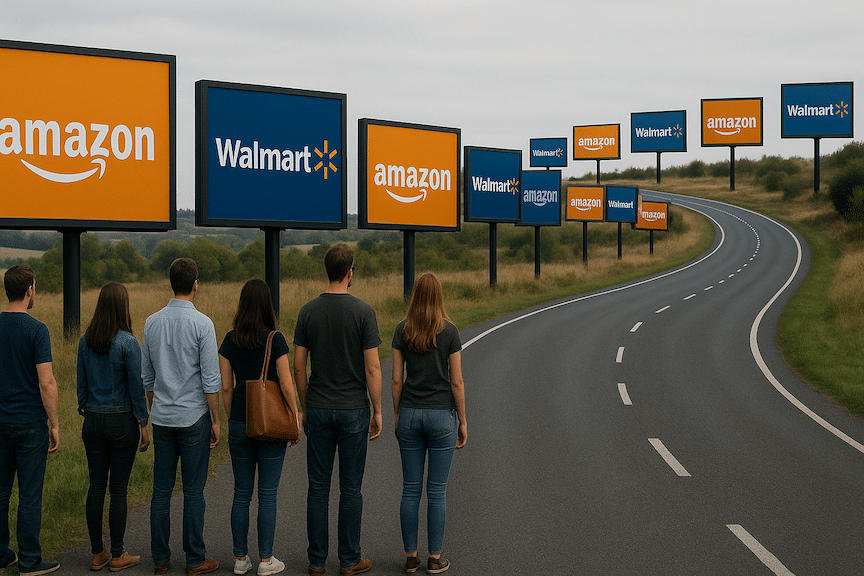Why Online Sellers Should Prepare for Increased Traffic in 2025
With brick and mortar stores closing, here’s how smart retailers are leveraging both channels to maximize their e-commerce success

The retail landscape is undergoing a seismic transformation. As we head into 2025, several macroeconomic and industry-specific factors are converging to drive this change.
Business Insider – and other publications – have reported that U.S. retailers have announced over 7,100 store closures through November 2024, a staggering 69% increase compared to the same period in 2023.
That’s presenting challenges AND opportunities for e-commerce businesses. Here’s why online sellers need to prepare and how they can make the most of this evolving retail environment.
Major Retailers Shutting Down Physical Locations
It’s not just smaller, under-capitalized retailers that are suffering.
An ongoing series of reports indicate that a number of prominent retailers are among those reducing their brick-and-mortar footprint:
- Family Dollar: Closing at least 600 stores.
- CVS Health: Consolidating locations nationwide.
- Big Lots: Closing 960 stores.
- Rite Aid: Nearly 200 locations shuttered.
- Walmart: 11 store closures in 2024.
- Target: Nine stores closed in 2024.
- Gap: Around 350 stores closing by the end of 2024
- Express: Approximately 100 stores being phased out.
As these household names diminish their physical footprints, consumers are left searching for alternative shopping experiences—a gap that online sellers are uniquely positioned to fill.
What’s Driving the Shift to Online Shopping?
Several key factors are accelerating the transition from traditional retail to e-commerce:
Economic Pressures
- Rising inflation and interest rates have led to increased operational costs for retailers, prompting them to close underperforming stores.
- Many retailers are prioritizing e-commerce investments over expensive brick-and-mortar locations.
Changing Consumer Behavior
- The pandemic-era boom in online shopping has fundamentally altered consumer habits.
- Remote work and flexible schedules mean more consumers are shopping from the comfort of their homes.
Operational Challenges
- Retailers are grappling with debt restructuring, higher labor costs, and supply chain disruptions.
- These challenges have made maintaining physical stores increasingly unsustainable for some brands.

Brick and Mortar Closures: A Cascading Effect on Online Sales
Contrary to what we might think, store closures – for those same brick and mortar stores – can negatively affect online local sales. Here’s what research suggests:
Forbes reports that after closing a store, retailers often lose nearly 12% of online sales in the affected area. For some categories, the impact is even more pronounced:
- Fashion: 22% decline in online sales.
- Home goods: 32% drop in online sales.
- Department stores: 26% reduction in online sales.
Physical stores create a “halo effect” that boosts online sales in their local area. When stores close, brand awareness decreases, customer trust erodes, and valuable in-person product interactions disappear.
Successful retailers understand this omnichannel synergy—physical locations serve as powerful marketing tools that drive digital performance. This relationship highlights why even digitally-focused brands like Amazon and Walmart continue investing in brick-and-mortar presence alongside their e-commerce operations.
Opportunity in Disruption: The Strategic Advantage
The decrease in local online sales following store closures creates a unique opportunity for prepared e-commerce sellers. When established retailers retreat from physical locations, they inadvertently leave a digital gap in consumer engagement.
Savvy sellers who understand this dynamic can strategically target these affected areas with tailored marketing campaigns, competitive pricing, and enhanced customer experiences.
However, success requires more than simply recognizing the opportunity—it demands a comprehensive strategy that addresses the lost touchpoints consumers previously valued.
Those with data-driven approaches to identify recently affected markets and the resources to quickly establish brand presence will capture the greatest share of this redistributed consumer spending.
How Individual Online Sellers Can Benefit
For e-commerce brand entrepreneurs and businesses, the decline of traditional retail presents a number of opportunities:
Expanded Customer Base
With fewer physical stores, more consumers are expected to shop online. This expanded audience opens doors for e-commerce businesses to capture new customer segments and build long-term relationships.
IIncreased Product Demand
The types of stores closing—discount chains, pharmacies, and department stores—suggest a growing online demand for:
- Everyday essentials (e.g., groceries, household goods).
- Health and wellness products (e.g., over-the-counter medications, supplements).
- Apparel and lifestyle items previously purchased in stores like Gap and Express.
Opportunities in “Retail Deserts”
The closure of over 7,000 pharmacies since 2019 has created “pharmacy deserts” in many areas. Online sellers specializing in health and wellness products can step in to fill this critical gap, offering convenient delivery and subscription models to serve underserved communities.
Preparing for the Influx of Online Shoppers
To make the most of the expected increase in online traffic, e-commerce businesses need to prioritize preparation and strategy. Here’s how:
Diversify Product Offerings
All those retail sales have to go somewhere.
- Analyze market trends to identify emerging demands.
- Expand product catalogs by adding items from closed physical stores.
- Test niche categories to uncover untapped opportunities.
Invest in Marketing and Outreach
Social commerce is exploding. 2025 is your opportunity to blend an accelerated social presence with influencer partnerships.
- Strengthen your social media presence to engage potential customers.
- Implement targeted email campaigns for personalized communication.
- Collaborate with influencers to expand reach and credibility.
- Optimize for search engines to improve online visibility.
Leverage Technology for Growth
- Utilize AI-powered, listing optimization, and other e-commerce tools to enhance the customer experience.
- Adopt an omnichannel approach by selling on platforms such as Amazon, Walmart, and TikTok Shop to broaden your audience.
- Use next-level analytics tools from these platforms to refine product listings, optimize pricing strategies, and calibrate your marketing efforts more effectively.

Looking Ahead: 2025 and Beyond
The retail sector’s ongoing transformation is a wake-up call for online sellers. Just last month, The Container Store filed for bankruptcy protection. That accompanies the 45 other retailers that have filed for bankruptcy in 2024. That’s a sharp increase from the 25 in 2023 and signals a period of unprecedented opportunity for e-commerce businesses.
By anticipating the influx of online shoppers and taking proactive steps to meet their needs, sellers can position themselves for sustainable growth.
If you’d like to take advantage of a strategy that many Amazon, Walmart, and TikTok sellers use to win their niche, reach out to the pros at Canopy Management—a full-service marketing agency staffed by multi-million dollar, omni-channel entrepreneurs, industry leaders, and award-winning, e-commerce experts.
Ready to Start Growing Your Amazon Brand?
Canopy’s Partners Achieve an Average 84% Profit Increase!
Find out more

